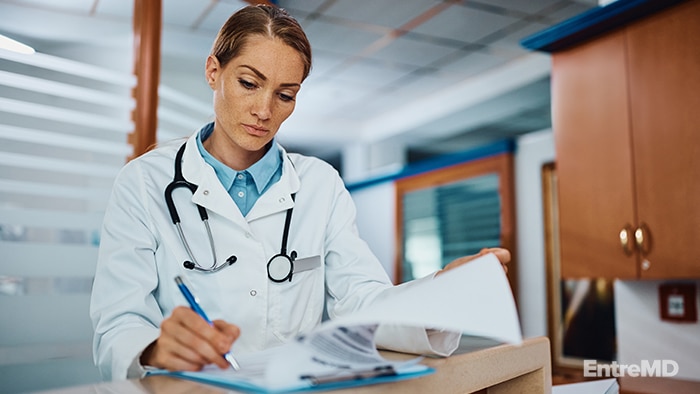More and more people are seeing the importance of creating multiple income streams for various reasons. The opportunity to work remotely and freelance has opened up many ways to earn extra income from the comfort of your home and with just a high-speed internet connection.
Some of the top benefits of having several streams of income include:
- A step towards financial independence
- Greater financial stability and safety
- Economies of scale
- Working when and where you choose
- Living life on your own terms
One of the ways physicians can create another stream of income is by picking up a side gig or side hustle, as it’s also known. I’ve dug into several side gigs and want to let you know what I’ve learned about becoming a physician chart reviewer.
Physician Chart Reviewers
In a nutshell, physician chart reviewers “review patient charts and medical records and make recommendations regarding medications, treatments, medical procedures, and other treatment plans.”
The term “chart review” is commonly used to describe an activity in which a doctor examines medical documents so they can decide about a “predetermined question or identify information that will assist in answering that question.”

Several organizations use medical charts for their own purposes, as they are considered clinical and legal documents. Medical charts record every step in a patient’s history, including:
- Patient identification
- Listed physician(s) and consultation dates
- Medical history
- Risk factors
- Drug reactions and allergies
- Annual exams, immunizations, disease surveillance
- Current medication with dosage and frequency
- All reports from other doctors or healthcare physicians
- Medical examination or consultation notes
- Any ordered investigations and results
- Diagnoses and provisional diagnoses
- Treatments prescribed or administered
- Advice given
- Referrals
- Copies of emails (and other communication) with patient
Qualifications to Become a Medical Chart Reviewer
Most physician chart reviewer jobs require you to be a practicing physician. You’ll need to be board-certified and have a valid and up-to-date state medical license and a “federal DEA or Controlled and Dangerous Substances (CDS) license.”
Additional certifications depend on the type of organization a physician chart reviewer works for.

The most common types of organizations that look for and hire physician chart reviewers are:
- Hospitals and medical facilities
- Independent review organizations (IRO)
- Insurance companies
- Workers’ compensation boards
- Legal firms
- Research organizations
Hospitals require a physician who has considerable experience along with their board certification and a license to practice medicine. Some organizations (but not all) prefer their physicians who are currently practicing medicine.
Apart from physician certification and licenses, you’ll want to enjoy paying attention to details and be self-motivated and organized with excellent written and verbal communication skills. Speed reading is another skill that can be helpful when reviewing medical charts and reports.
Certifications for Physician Medical Chart Reviewers
There are a few organizations that offer certifications for physician medical chart reviewers. The two most well-known are the National Association of Independent Review Organizations (NAIRO) and the American Board of Quality Assurance and Utilization Review Physicians (ABQAURP).
According to the NAIRO website, an independent review organization (IRO) acts as a “third-party medical review resource which provides objective, unbiased medical determinations that support effective decision making, based only on medical evidence. IROs deliver conflict-free decisions that help clinical and claims management professionals better allocate healthcare resources.”
Members join NAIRO to become accredited. This accreditation is designed to:
- Make sure IROs are “free from [any] conflicts of interest.”
- Award qualifications for physicians who perform independent medical peer reviews.
- Speak to medical necessity and experimental treatment issues.
- Set “reasonable” periods for standard and expedited peer reviews and appeals processes.
Accredited IROs are subject to a thorough review over four phases for approximately one year. This first phase typically takes several months and involves completing application forms and providing the organization with all supporting documents.
Once the application has been approved, the remaining three phases (which take approximately six months) include a desktop review, an onsite review, and a committee review. Once the physician has passed the requirements, they will be awarded a two-year accreditation.

Currently, NAIRO has grown to over 30 members, which represent the majority of accredited IROs. There are three membership tiers — Full, Associate, and Affiliate. All members in “good standing” are listed on the Members page and receive “updates on legislative and regulatory updates.”
| Full | Associate | Affiliate | ||
| 19+ employees | 2-19 employees | Individual member | ||
| $3,500 | $3,000 | $2,500 | $1,000 | $500 |
ABQAURP also provides certification, which may not be required. Still, it could be helpful if you’re looking to make yourself more marketable. Their mandate is to “bring health care quality and management to the forefront by providing the highest standard of education, information, and resources to its members.”
You can earn up to 5 CME/CE with their Utilization Management Peer Reviewer Training. This online course presents the “principles and procedures of Utilization Review and Utilization Management standards as required by URAC’s Health Utilization Management Accreditation and American Accreditation Health Care Commission under the Health Utilization Management Standards.”
The course description promises that after the course, attendees will be able to:
- Evaluate utilization review cases using the appropriate review process.
- Interpret utilization review terminology and concepts.
- Compare and contrast differences between the various types and levels of utilization review.
- Write clear and concise utilization review determination reports.
- Integrate clinical and medical reference material to create an appropriate determination rationale.
- Recognize applicable standards as applied to utilization review activities.
- Apply utilization review process to improve personal clinical practice.
- Recognize the difference between internal and external reviews.
- Describe the external review process.
Chart Reviews for Hospitals and Medical Facilities
Healthcare organizations use medical chart reviews to determine the suitability of care as well as to keep costs to the hospital down. If care is needed but not covered or if the type of care isn’t straightforward, a qualified physician will review the patient’s medical chart to consider how long the patient needs to stay in the hospital, if they can be cared for at home or another medical facility, and if they are receiving the care they need.
A physician chart reviewer will recommend medications, treatments, procedures, physical therapy, or additional services. Most often, the chart reviewer will speak to the referring physician or practitioner to get a clearer picture of the patient’s care to date and to understand any plan going forward.

Chart reviews are also important as a way to ensure there is quality management and oversight in the hospital or medical facility. This review allows the hospital to gather data before they make changes to processes or policies related to quality improvement projects.
Hospitals usually hire at least one full-time physician chart reviewer. They assess pre-authorization for non-urgent medical requests and those not covered by the patient’s insurance plan. Concurrent hospitalization reviews deal with care issues while a patient is already hospitalized.
Chart Reviews for Insurance Companies and Workers’ Compensation Boards
Insurance companies hire physician chart reviewers to accurately review injury claims to determine a fair and independent claim settlement. The physician will analyze records and find information beyond a diagnosis and prognosis.
They look for any prior medical problems the client may have had, along with a list of medications they were taking before the injury claim. They also look for any contraindications to see if there are conflicts within the case and if there is any missing information in the records.

In calculating insurance premiums, insurance companies want to assess an individual’s current health and well-being and if they have any pre-existing conditions that would cost the insurance company more than the premiums paid.
If a potential client is already in poor health, a physician will be asked to review their medical chart to see what medical problems impact how long they live and what caring for them might cost in terms of medications, treatments, and hospitalization.
When workers are injured on the job, workers’ compensation boards will want their claim files reviewed before issuing any disability payments. The employee will be treated by their own doctor, and it’s the role of a physician chart reviewer to look through and provide an opinion on whether the claim is valid.
Chart Reviews for Legal Firms
Another term for physician chart reviews for the legal profession is “expert witness work.” This type of chart review is used for court cases, and physician chart reviewers can be hired by either the defense or the plaintiff teams to translate and interpret medical charts.
Nancy Hammond, MD, received a cold call asking her to be the expert on record for a local legal case. She then offered her services as a medical chart reviewer to other lawyers in town. Hammond recommends taking the Skills, Education, Achievement, Knowledge (SEAK) course.

Other suggestions from physicians who found work as a part-time, side gig medical chart reviewer include reaching out to anyone in the medical or legal field doing this type of work, networking with physician colleagues, and contacting the American Forensic Specialists (AMFS). They hire doctors for expert medical opinions and connect lawyers with qualified physicians.
Organizing the medical charts is the first step in most personal injury litigation matters. This provides a clear timeline of the patient’s injury from the time the injury happened until the present and helps determine liability.
Chart Reviews for Research Organizations
Medical chart reviews are used to extract data for research projects. A chart review is usually conducted with human participants. There are two types of chart reviews — retrospective and prospective. A retrospective chart (RCR) happens with patient data that already exists in their medical files. A prospective chart review evaluates patient data that doesn’t exist in their medical record.
Some studies combine both retrospective and prospective chart reviews. You should work closely with the IRB to determine the requirements for both portions of the study and develop a plan to stay in compliance if requirements are different for each portion.
This type of medical research can be done on behalf of an academic medical institution, a university, or a private research bank. It requires approval from the subjects before their charts may be accessed.
The data will be compiled from electronic databases, diagnostic tests, and notes from doctors’ files. RCR is a specific and popular research design that uses “pre-recorded, patient-centered data…to answer one or more research questions.”

When using medical records for healthcare operations, the same rules don’t apply, and IRB review isn’t required. This covers “medical records used for individual patient treatment, in-house use of medical records or program evaluations if not for publication.”
No matter what type of charts you might be hired to review, each review shares three things:
- The review must be objective and impartial.
- The reviewer must be an experienced and knowledgeable medical professional.
- The reviewer is only concerned with reviewing chart information on a patient and does not treat or direct the patient’s care.
MDLinx released an article on the results of a recent survey they conducted on more than 1,200 doctors regarding how the pandemic affected them personally and professionally. Three hundred doctors reported they had started a side hustle to add to their income, and four were willing to share their stories.
One of the four doctors told MDLinx that she reviews medical records for a “finance company that invests in life insurance policies.” Her reviews estimate the life expectancy of applicants and typically take about three to four hours each week. She is earning anywhere from $1,000 to $3,000 each month from this extra part-time work.
“I enjoy this because it allows me to expand my medical experience and learn about how patients are being treated and faring around the country,” she reported, “but sometimes the record reviews can be tedious.”
There were no startup costs to reviewing medical charts, and the work’s flexibility makes it a good option for her as she can fit the work in whenever she has time.
In a search on ZipRecruiter for physician chart reviewer jobs, the site shows that most salaries in this field pay between $44,500 and $103,000 yearly. They describe the chart reviewer’s schedules as flexible, with a varied workload.
“Some physician chart reviewers work on an as-needed basis, while other jobs are a fixed period or long-term. Depending on your employer, you can perform your responsibilities from home or a remote setting.
There are lots of open positions nationwide for Medical Chart Review Physician job searches, with results showing about 223,000 jobs hiring now on ZipRecruiter.”
The most popular physician chart reviewer job categories:
- Medical Chart Abstraction
- Legal Medical Chart Review
- Medical Chart Review
- Insurance Utilization Review
- Dental Chart Review
- PT OT Utilization Review
- Insurance Nurse Reviewer
- Chart Auditing
- Chart Review Nurse Practitioner
- Insurance Chart Review
Most companies carry errors and omissions in malpractice insurance, but if they don’t, you may want to consider getting your own policy. Your report should clearly state that you haven’t seen the patient in person and that any recommendations are made on information you were provided during the review process.
Becoming a medical chart reviewer is one way to combine your doctor’s work with your drive toward entrepreneurship. If you’re looking for other ways to make money, have an impact, and have time for the things that matter, The EntreMD Business School is waiting for you.
I created the EntreMD Business School for physician entrepreneurs to fast-track their way to building profitable businesses so they can live life and practice medicine on their own terms.
This could be just what you’re looking for. Click the link above and come check it out!


